[vue]组件的导入
参考: http://vue2.mmxiaowu.com/article/584a3957fc007e72b0f576d9
vue组件的注册
1.通过components方式注册
2.通过router方式注册(两者可以并行存在).
3.如果是render+router方式, 那么router只能写在render的组件template里.
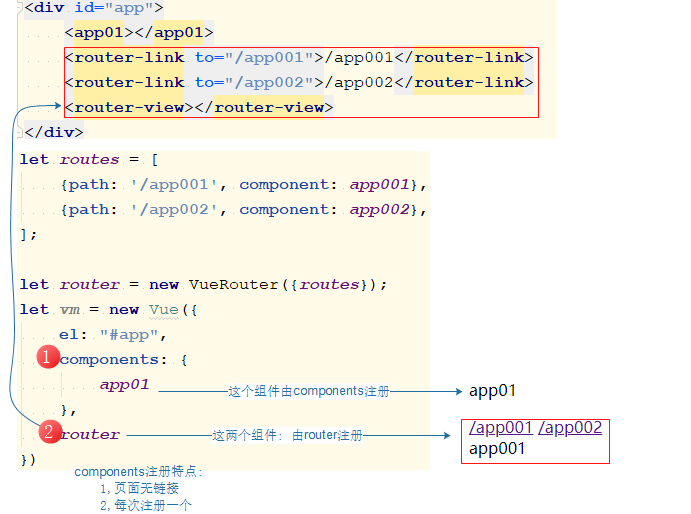

<!DOCTYPE html>
<html lang="en">
<head>
<meta charset="UTF-8">
<title>Title</title>
</head>
<body>
<div id="app">
<app01></app01>
<router-link to="/app001">/app001</router-link>
<router-link to="/app002">/app002</router-link>
<router-view></router-view>
</div>
<template id="app01">
<div>
<p>app01</p>
</div>
</template>
<template id="app001">
<div>app001</div>
</template>
<template id="app002">
<div>app002</div>
</template>
<script src="node_modules/vue/dist/vue.js"></script>
<script src="node_modules/vue-router/dist/vue-router.js"></script>
<script>
let app01 = {
name:'app01',
template: "#app01",
};
let app001 = {
name:'app001',
template: "#app001",
};
let app002 = {
name:'app002',
template: "#app002",
};
let routes = [
{path: '/app001', component: app001},
{path: '/app002', component: app002},
];
let router = new VueRouter({routes});
let vm = new Vue({
el: "#app",
components: {
app01
},
router
})
</script>
</body>
</html>
router方式灵活,可以作为components注册组件的子组件存在
作为谁的子, 取决于router-link和router-view写在谁下了.

<!DOCTYPE html>
<html lang="en">
<head>
<meta charset="UTF-8">
<title>Title</title>
</head>
<body>
<div id="app">
<app01></app01>
</div>
<template id="app01">
<div>
<p>app01</p>
<router-link to="/app001">/app001</router-link>
<router-link to="/app002">/app002</router-link>
<router-view></router-view>
</div>
</template>
<template id="app001">
<div>app001</div>
</template>
<template id="app002">
<div>app002</div>
</template>
<script src="node_modules/vue/dist/vue.js"></script>
<script src="node_modules/vue-router/dist/vue-router.js"></script>
<script>
let app01 = {
template: "#app01",
};
let app001 = {
template: "#app001",
};
let app002 = {
template: "#app002",
};
let routes = [
{path: '/app001', component: app001},
{path: '/app002', component: app002},
];
let router = new VueRouter({routes});
let vm = new Vue({
el: "#app",
components: {
app01
},
router
})
</script>
</body>
</html>
render方式注册组件
上面这个链接里说了: render+router

方法1:
render: c => c(app01)作用:
0,注册组件
1.生成标签
2.自动插入标签
特点: 会覆盖div.app下的内容
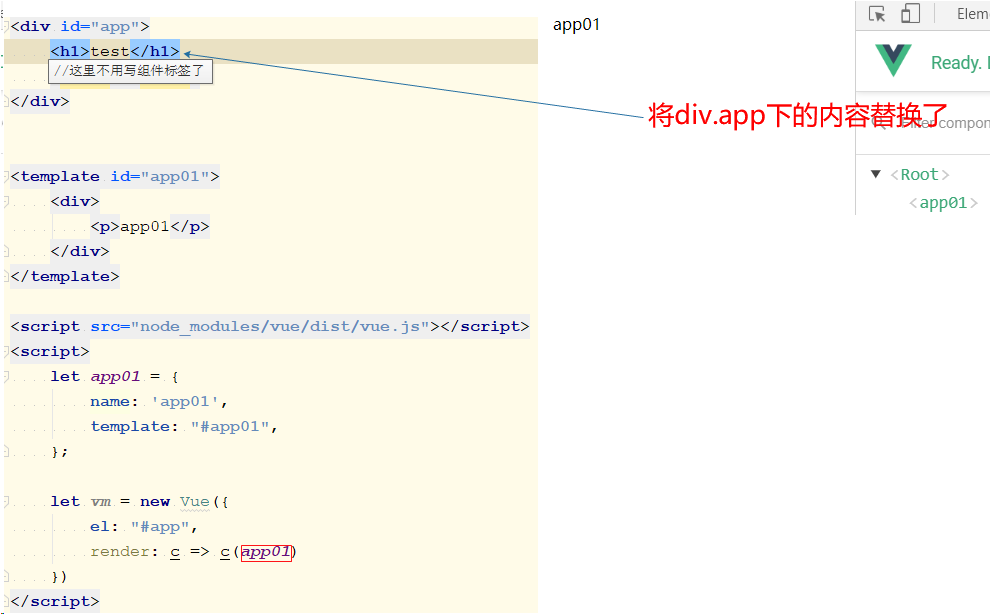
方法2:
render: c => c('app01')作用:
1.生成标签
2.自动插入标签
特点: 会覆盖div.app下内容
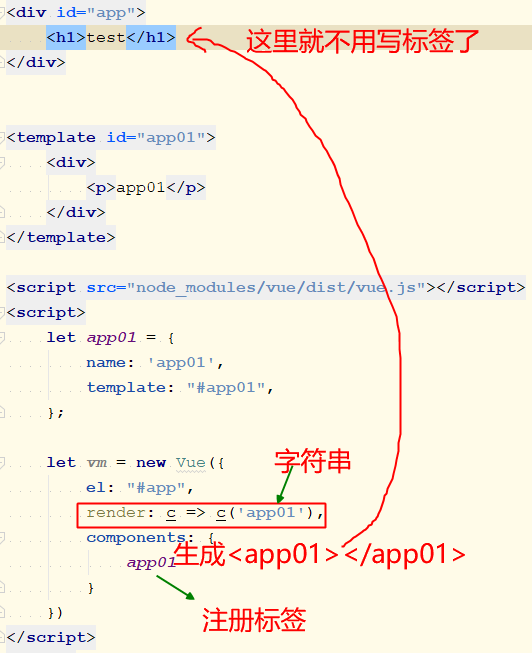
document的的创建标签方法
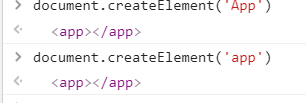
方法3: template
template: '' 作用:
1,生成标签
2,插入标签
特点: 会覆盖app下内容
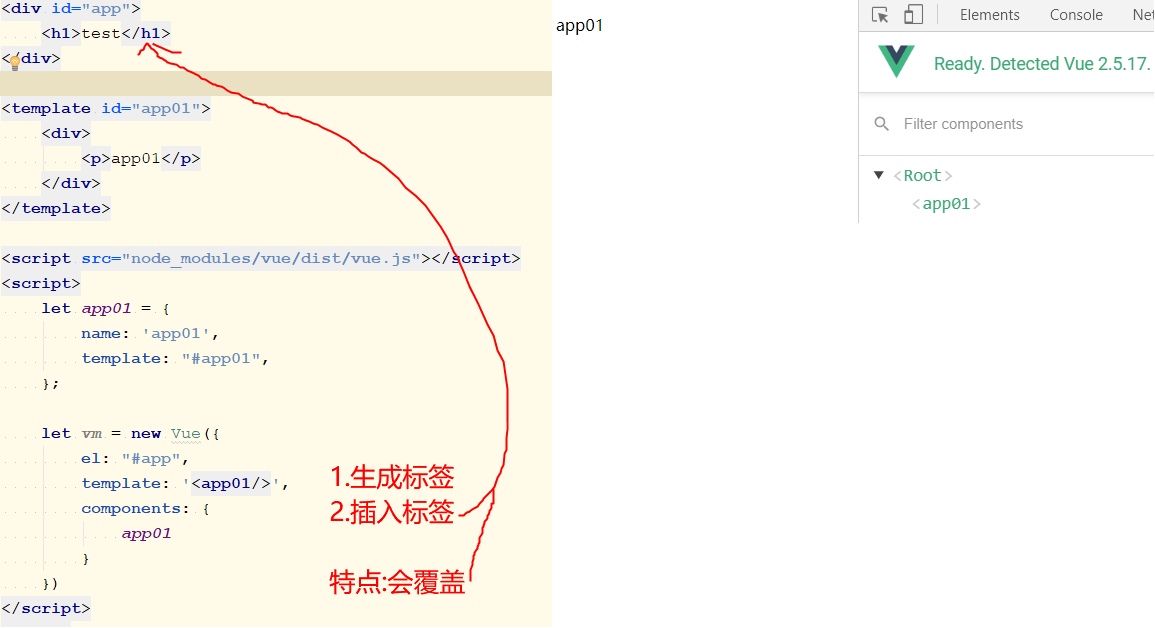
<!DOCTYPE html>
<html lang="en">
<head>
<meta charset="UTF-8">
<title>Title</title>
</head>
<body>
<div id="app">
<h1>test</h1>
</div>
<template id="app01">
<div>
<p>app01</p>
</div>
</template>
<script src="node_modules/vue/dist/vue.js"></script>
<script>
let app01 = {
name: 'app01',
template: "#app01",
};
let vm = new Vue({
el: "#app",
template: '<app01/>',
components: {
app01
}
})
</script>
</body>
</html>
小结:

| render: c => c('app01') | template: '' |
|---|---|
| 1.生成标签 | 1.生成标签 |
| 2.插入标签 | 2.插入标签 |
| 覆盖app下的内容 | 覆盖app下的内容 |
| 配合runtime用 | 配合vue.js用 |
| 局部组件 | 全局组件 |
|---|---|
| 1.创建 | 1,创建 |
| 2.注册 | - |
| 3.使用 | 3,使用 |
第二栏是 template: '<app01/>'
webpack: 使用render+runtime-only方式
- 方法1
new Vue({
el: '#app',
render: creatElment => creatElment(App),
});
- 方法2
通过render渲染一个元素, 然后把 App 当组件来用
new Vue({
el: '#app',
render: c => c('App'),
components: {
App
}
});
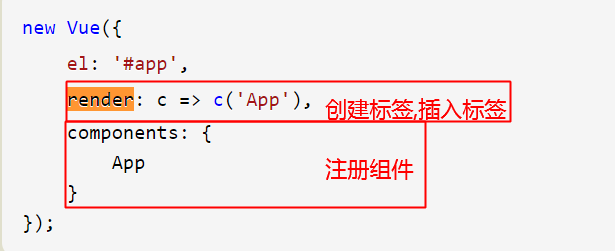
注意: 这种情况下, App 组件并不是根组件
webpack: 使用vue.js
- 方法3:
<div id="app">
<App></App>
</div>
import Vue from '../node_modules/vue/dist/vue.js'
import App from "./App.vue";
new Vue({
el: '#app',
components: {
App
}
});
- 方法4:
import Vue from '../node_modules/vue/dist/vue.js'
import App from './App.vue'
new Vue({
el: '#app',
template: '<App/>',
components: {
App
}
});
webpack: vue-cli使用的方式
vue-cli默认使用的是../node_modules/vue/dist/vue.js,而非runtime.

import Vue from '../node_modules/vue/dist/vue.js'
import App from './App.vue'
import login from './components/login.vue';
import register from './components/register.vue';
import VueRouter from 'vue-router';
Vue.use(VueRouter);
let routes = [
{path: '/login', component: login},
{path: '/register', component: register},
];
let router = new VueRouter({routes});
new Vue({
el: '#app',
template: '<App/>',
components: {App},
router
});
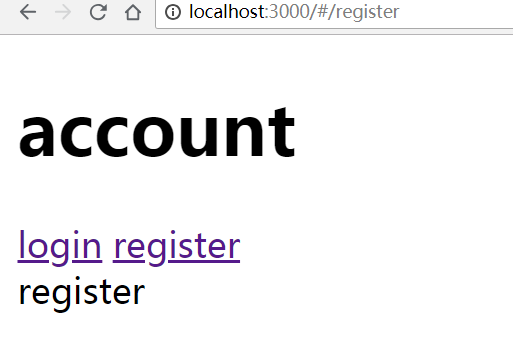
- 将login和register直接导入App.vue
- 将login和register先导入account.vue, 在将account.vue导入App.vue/
router方式导入
./components/login.vue
<template>
<div>login</div>
</template>
<script>
export default {
name: "login"
}
</script>
<style scoped>
</style>
./components/register.vue
<template>
<div>register</div>
</template>
<script>
export default {
name: "register"
}
</script>
<style scoped>
</style>
./components/account.vue
<template>
<div>
<router-link to="/account/login">/account/login</router-link>
<router-link to="/account/register">/account/register</router-link>
<router-view></router-view>
</div>
</template>
<script>
export default {
name: "account"
}
</script>
<style scoped>
</style>
App.vue
<template>
<div id="app">
<router-link to="/account">/account</router-link>
<router-view></router-view>
</div>
</template>
<script>
export default {
name: 'app',
}
</script>
<style>
</style>

import 方式实现
./components/login.vue
<template>
<div>login</div>
</template>
<script>
export default {
name: "login"
}
</script>
<style scoped>
</style>
./components/register.vue
<template>
<div>register</div>
</template>
<script>
export default {
name: "register"
}
</script>
<style scoped>
</style>
./components/account.vue
<template>
<div>
<p>account</p>
<login></login>
<register></register>
</div>
</template>
<script>
import login from './login.vue';
import register from './register.vue';
export default {
name: "account",
components: {
login,
register
}
}
</script>
<style scoped>
</style>
App.vue
<template>
<div id="app">
<account></account>
</div>
</template>
<script>
import account from './components/account.vue'
export default {
name: 'app',
components: {
account
}
}
</script>
<style>
</style>

[vue]组件的导入的更多相关文章
- 自己封装 vue 组件 和 插件
vue 组件 一.组件的创建,两种方法.(本质上是1.2两种,vue文件,只是创建了一个 组件选项对象,仅是一个js对象)1.定义组件:Vue.component('button-counter', ...
- 基于vue项目的组件中导入mui框架初始化滑动等效果时需移除严格模式的问题
基于vue项目的组件中导入mui框架初始化滑动等效果时,控制台报错:Uncaught TypeError: 'caller', 'callee', and 'arguments' properties ...
- Vue (三) --- Vue 组件开发
------------------------------------------------------------------好心情,会让你峰回路转. 5. 组件化开发 5.1 组件[compo ...
- vue2.0 如何自定义组件(vue组件的封装)
一.前言 之前的博客聊过 vue2.0和react的技术选型:聊过vue的axios封装和vuex使用.今天简单聊聊 vue 组件的封装. vue 的ui框架现在是很多的,但是鉴于移动设备的复杂性,兼 ...
- vue 组件开发、vue自动化工具、axios使用与router的使用(3)
一. 组件化开发 1.1 组件[component] 在网页中实现一个功能,需要使用html定义功能的内容结构,使用css声明功能的外观样式,还要使用js定义功能的特效,因此就产生了一个功能先关的代码 ...
- 如何把一个vue组件改为ionic/angular组件
同是mvvm框架,他们之间是很相似的,如何你已经熟悉其中的一个,那么另一个也就基本上也就会的差不多了. 一.动态属性.值.事件绑定 vue中使用v-bind:或者之间分号:进行绑定 ng中左括号[]进 ...
- storybook构建vue组件
最近在研究业务型组件的使用,因为在单独开发组件的时候需要调试,所以为每一个组件都编写一个webpack开发环境,然后上传上去为了其他人可以直接使用又把webpack上传上去,这样会有两个问题: 1:每 ...
- VUE组件汇总
内容 UI组件 开发框架 实用库 服务端 辅助工具 应用实例 Demo示例 UI组件 element ★13489 - 饿了么出品的Vue2的web UI工具套件 Vux ★8133 - 基于Vue和 ...
- vue 组件发布记录
好久没做独立的 vue 组件了,最近突然想把一个常用的 vue 组件打成一个 npm 包,方便使用.好久不用,发现已经忘记环境怎么搭建.翻看以前的组件,才慢慢回想起来,中间还出现些错误.在这记录下开发 ...
随机推荐
- GIAC2018全球互联网架构大会深圳站盛况回顾,定格精彩瞬间!
6月1日至2日,由知名软件培训公司msup和高可用架构联合推出的GIAC全球互联网架构大会在深圳华侨城洲际大酒店盛大召开.来自国内外顶级互联网公司.诸多著名科技图书作者在内的71名海内外著名专家与现场 ...
- 如何将sql查询出的结果,用符号隔开
晚饭过后,打开QQ圈子,发现QQ群里有人提问了一个问题↓ 数据表中有这样的数据 如何转换为 ,, , 知道写存储过程或者函数可以解决,但是想想能不能用一条sql语句解决...未果... 还是去搜索了下 ...
- 一、SQL定义变量
http://blog.csdn.net/changwei07080/article/details/7561602 在SQL我们使用declare定义局部变量,同时可以使用set和select 对变 ...
- {MySQL的库、表的详细操作}一 库操作 二 表操作 三 行操作
MySQL的库.表的详细操作 MySQL数据库 本节目录 一 库操作 二 表操作 三 行操作 一 库操作 1.创建数据库 1.1 语法 CREATE DATABASE 数据库名 charset utf ...
- servlet @WebServlet注释的用法
package servlet; import java.io.IOException; import javax.servlet.ServletException; import javax.ser ...
- ESP8266 nodemcu
主要资料来源于一下几个网站 1.nodemcu官网:此处有几个示例和github(用处不大) 2.用户说明:http://nodemcu.readthedocs.io/en/master/ (非常重 ...
- CH #46A - 磁力块 - [分块]
题目链接:传送门 描述在一片广袤无垠的原野上,散落着N块磁石.每个磁石的性质可以用一个五元组(x,y,m,p,r)描述,其中x,y表示其坐标,m是磁石的质量,p是磁力,r是吸引半径.若磁石A与磁石B的 ...
- hbase与sqoop的集成
1.sqoop抽取mysql表到hbase中 export HBASE_HOME=/opt/cdh-5.3.6/hbase-0.98.6-cdh5.3.6 export HADOOP_HOME=/op ...
- Hive中的order by、sort by、distribute by、cluster by解释及测试
结论: order by:全局排序,这也是4种排序手段中唯一一个能在终端输出中看出全局排序的方法,只有一个reduce,可能造成renduce任务时间过长,在严格模式下,要求必须具备limit子句. ...
- CSS:Float
CSS 的 Float(浮动),会使元素向左或向右移动,其周围的元素也会重新排列. Float(浮动),往往是用于图像,但它在布局时一样非常有用. 元素怎样浮动 元素的水平方向浮动,意味着元素只能左右 ...
